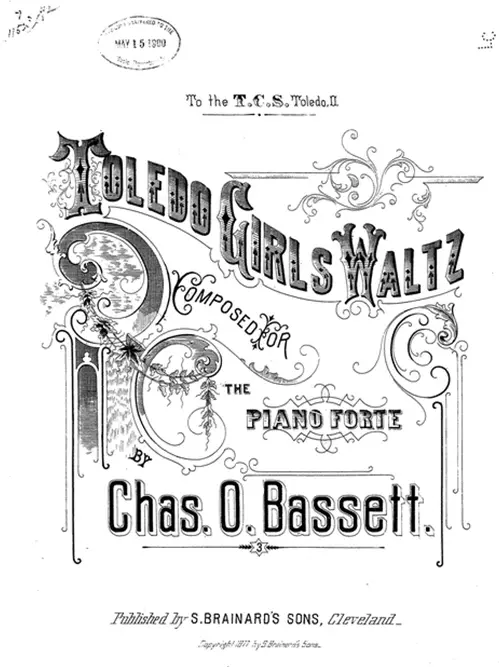by Timothy Messer-Kruse, 2001
 Program (cover) for the Toledo Girls Waltz
Program (cover) for the Toledo Girls Waltz
Every great city has its songs. Some, like Sinatra’s New York, New York, or Tony Bennett’s I Left My Heart in San Francisco evoke images that capture a city’s spirit. Some, like Woody Payne’s Sweet Home Chicago [*], become a city’s anthem, not so much for what they say about the place, than the way in which they say it. Songs have the power to capture the mood and soul of a city.
During the mid-nineteenth century, several songs and musical pieces were written about Toledo or places around it. There was the Toledo Girls Waltz, the Toledo Military Band March, the Bay View Waltz, and a tribute to one of Toledo's early amusement parks, Meet Me at White City. Many of these songs were published by the Woodward Music Company, a music publishing company that turned out scores of scores each month for decades. However, none of these songs really attempted to capture the city's spirit.
This changed near the turn-of-the-century. Over a dozen songs have been written about Toledo, Ohio and though none powerfully capture some universally recognized essence of the place, each of them reflects an interesting moment in the city’s history. From 1906 to 1992, balladeers have taken their turn at crafting the definitive city song. Though none achieved more than a minor fleeting fame in their own time, they serve well to chart the course of the city through the Twentieth century.
Progressive Toledo, 1906-1916
The first song describing Toledo, "We’re Strong for Toledo," was written by Joe Murphy in 1906. Murphy was the founder of the Citizen’s Ice Company and wrote the song for his barbershop singers, the Ice House Quartette. Murphy penned the original stanzas in a few evenings in the only key he knew. "We’re Strong for Toledo" reflected the vague optimistic spirit of Murphy’s age:
We’re Strong for ToledoWe’re strong for Toledo We’re strong for Toledo |
|
Murphy’s lyrics made few claims for the city he was born and raised in besides fair girls and square boys. This is its real strength. Unlike most of the succeeding tunes about Toledo that praise specific features, business opportunities, or institutions of the city, the generality of "We’re Strong" allowed it to suit the changing circumstances of the city.
 Joe Murphy and his Ice Quartette
Joe Murphy and his Ice Quartette
Still, at the song’s core is a quaint view of the city as a harmonious unified whole. 1906, the year Murphy wrote his song, was perhaps the last that the idea of Toledo’s people all sharing the same interests could have been so boldly proclaimed. Toledo’s civic leaders had long praised its unusual climate of labor peace. Toledo, unlike similar mid-sized manufacturing and transportation centers, had largely escaped the large scale strikes and violence of the great railroad strikes of 1877, the eight-hour day strike wave of 1886, and the Pullman Strike of 1894. Relative to other Ohio cities, it lost few workdays to strikes in the first six years of the Twentieth century. But less than a year after Murphy finished "We’re Strong for Toledo," one of the city’s largest manufacturing concerns, the Pope Automobile Company, was shuttered by a massive strike. By 1909, the construction trade unions and an employers association were at each other’s throats, and a bomb was discovered on the site of a downtown building project. By World War One, Toledo would be an organizing center for the militant I.W.W. (Industrial Workers of the World) union in Ohio.
Murphy’s ice quartette grew from four to forty over the next twenty years. Invited to perform at the 1927 Rotary International World Convention in Belgium, "We’re Strong for Toledo" was sung across Europe and to millions of WRKO radio listeners upon the group’s return to New York.
Joe Murphy must have been stung when the city adopted a rival’s song for its official ballad in 1909.
"Our Toledo", by George G. Morrison and Eusebius W. Dodge.
Dodge, president of the American College of Music in Toledo, composed a more impressive melody and Morrison packed more specifics about the city into his lyrics. The Toledo City Council first heard it sung by a chorus of twenty-five voices in their chambers above the Valentine Theatre and swiftly moved to adopt it as the city’s official song.
"Our Toledo" speaks more directly to that era’s Toledo’s Progressive politics and self-image:
Our ToledoToledo on Lake Erie Crowned, Toledo is the fairest A home of welcome and of cheer, Imperial Toledo leads, |
Clearly an optimistic song, "Our Toledo" did not merely boost the city but expressed some principles as well. It clearly echoed many of the concerns of the years just prior to World War One: stanzas spoke of justice, high ideals, meeting the people’s needs, the march of the commerce of the nation and preserving a happy, welcoming and cheerful domestic home. With Brand Whitlock as mayor, a man of letters who inherited Samuel "Golden Rule" Jones’ mantle of reform, claiming such a high moral character for their city did not seem to them presumptuous.
"Our Toledo" spoke confidently of the city’s status and growth. It did not have the whiff of desperation or fear that lingered around later songs. From the perspective of 1909, the city’s future did seem assured. Toledo continued to lead Ohio in percentage growth in the number of its factories, wage earners, and the level of its wages. In 1905 the editors of the Toledo News-Bee declared, "Thrifty, thriving, hustling Toledo, the gateway to the Northwest, has an industrial future radiant with promise to the investing manufacturer and to the wage earner." (July 10, 1905) So fast was the pace of population growth that by 1913, homeowners purchased lots and pitched tents while waiting for their turn for contractors to begin work. (Blade, July 11, 1913) As the city council voted "Our Toledo" the city’s official song it could look out its windows at the rising skyline — Tiedtke’s Department Store new six-story structure was just reaching completion down the block; plans were just announced for an even larger LaSalle and Koch store to be built the following year; a few miles north, the new home of the Toledo Mud Hens, Swayne Field, began its first season; the first of many expansions of the old Pope Automobile factory was being planned by its new owner, John North Willys; the first wireless radio broadcasts moved out from the city.
By 1916, there were many reasons for this optimistic spirit to dim. Chief among them was the growing conflagration spreading across Europe. Still, another Toledo resident, J.W. Crook, borrowed the wartime tune of "Tramp, Tramp, the Boys are Marching" and rewrote the lyrics into the "Toledo Song":
Toledo SongOn the banks of the Maumee |
|
Crook’s "Toledo Song," if nothing else, was certainly the most detailed of all Toledo tunes up to this point. Less a song than a business prospectus, it nevertheless does carry a few interesting references: it remembers mayor Samuel "Golden Rule" Jones who died in office over a decade before, it makes a patriotic appeal to service in wartime, it mentions Toledo’s natural advantages, though Crook may have bent the truth a bit with his "winters warm and summers cool" claim.
Most interestingly it notes a few of the city’s deficiencies as well as its strengths (something that few later songs could bear to do — only an optimistic generation can graciously admit its flaws). In stanza four, Crook notes that the city lacks a decent downtown bridge across the broad Maumee that would connect the East and West sides of town; that the city was one of the few with a population over 100,000 in the country that did not have its own city hall (city court, council, and mayor’s chambers and offices occupied the top two stories of a downtown theatre); and the baseball team didn’t amount to much until Casey Stengel arrived to manage it in 1926.



